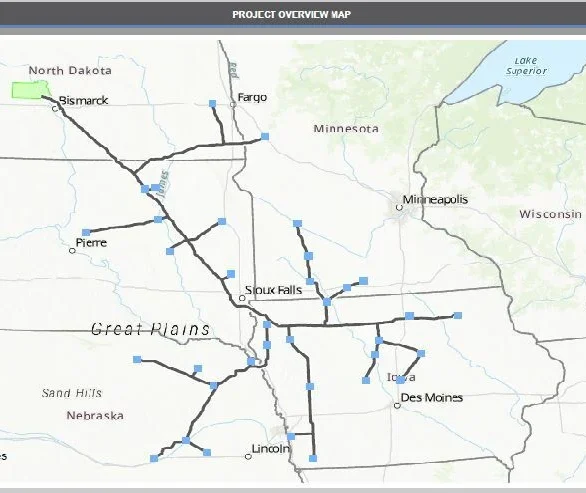
Landowner concerns still surround proposed CO2 pipeline; developer forging ahead
Landowner concerns continue to grow over a proposed pipeline that would pick up carbon dioxide emissions from ethanol plants in several Midwestern states and transport them to North Dakota for permanent storage.
Developer Summit Carbon Solutions says it hopes to come to agreeable terms with landowners on easements before considering eminent domain.
A group of landowners and representatives from the Dakota Resource Council environmental group discussed Summit’s proposed $4.5 billion Midwest Carbon Express pipeline during a meeting Tuesday night at the Bismarck Veterans Memorial Public Library.
The pipeline is to pick up climate-warming carbon dioxide from more than 30 ethanol plants and other facilities in the Midwest, crossing 2,000 miles through five states to Oliver and Mercer counties northwest of Bismarck, where the emissions would be injected and stored underground.
The line is slated to pass through the Dakotas, Minnesota, Nebraska, and Iowa. Construction is planned for next summer, and operations are to begin in late 2024.
For many landowners whose properties lie within the project area, the potential use of eminent domain remains a concern. Eminent domain would involve the seizure of land for the project if property owners can’t reach an agreement with the company; those landowners would still be compensated but likely not at the level they sought.
Kurt Swenson, who lives on an Oliver County farm that has been in his wife’s family for 111 years, has been vocal about his concerns regarding the project since the developer sought to inject carbon dioxide emissions below his land.
“Our landowner group is really wanting for Summit to respect the rights of private property owners,” Swenson said in a Tribune interview.
He has been working with an attorney and other landowners in the area, hoping to negotiate different terms for an easement. His property is not on the pipeline route but is in an area where Summit wants to sequester carbon dioxide in underground rock cavities known as pore space. Swenson believes the terms of the easement he’s been offered aren’t favorable.
He’s part of a growing group of 20 families in Oliver and Mercer counties that have met with the company multiple times to try to negotiate a better contract.
“We’re not opposed to the project, but we wanted to do it under different terms and conditions versus the contract they had provided,” Swenson said, adding that the proposal is “woefully underpaid compared to leases in Texas and Louisiana.”
Summit Executive Vice President Wade Boeshans told the Tribune on Tuesday that the company has completed the engineering for the project and is still acquiring easements from landowners across the five-state area. The company has acquired just over 35% of the right-of-way in North Dakota, and about 40% of the right-of-way across the project.
“So we are putting the engineering in the pipeline system here later this year. We’re proceeding with our state and federal permits,” he said, adding that he anticipates the company will file a permit request with the North Dakota Public Service Commission later this year.
Boeshans said most landowners when they sit down with Summit “understand that this project is material to the future of agriculture and the future of energy in our state.”
However, “Not everybody’s sold on the concept of capturing and storing CO2,” he said, adding that it’s a battle with those opposed to traditional energy and modern agriculture.
A study by Ernst & Young paid for by Summit concluded that the North Dakota investment during the construction phase of the pipeline would be $898 million, with $61 million in state and local taxes paid by the company. The study also concluded that during pipeline operations, the annual North Dakota expenditures would be $18 million, with $8 million in state and local taxes paid by Summit.
Though Summit has the option of eminent domain to obtain the land it needs, Boeshans said the company’s focus is to work out “agreeable terms” with landowners. The company also has adjusted the planned route more than 1,300 times, he said.
Commissions in six North Dakota counties have passed resolutions opposing the potential use of the eminent domain for the pipeline, according to Summit: Burleigh, Emmons, Sargent, Richland, Dickey, and McIntosh.
During Tuesday’s landowner meeting, attorney Brian Jorde noted that such resolutions are not binding.
Swenson said price is only one concern — that landowners also want some control in what goes on.
“So much of it involves the use of our surface lands because essentially if you think about pore space, most people think well, it’s a mile or 2 miles under the ground. What’s the big deal? But the way their contract reads is they get access to every square inch of your surface property and do whatever they … deem necessary for their project,” he said. “So we could end up with a compressor station right outside our bedroom window with light shining and noise coming into our house 24/7 if they wanted to do that.”
The pipeline route goes around Bismarck about 5 to 10 miles northeast of the city and crosses the Missouri River north of Mandan.
Art Rode, who lives 5 miles outside of Bismarck, said he succeeded in the spring in getting the proposed pipeline route off his property. However, he still believes the pipeline is too close to an expanding Bismarck.
“Do we need this close to Bismarck? Where is Bismarck going to be in 70 years? Do we want a 2-foot diameter CO2 line running through residential areas around Bismarck?” Rode told the Tribune, suggesting that the project would be better placed in a more rural area.
“We’ve got one chance to do this right,” he said. “If we screw it up, we’re going to live with it for the rest of our lives.”
